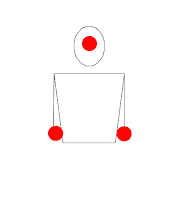Many of the brightest threads in my tapestry of memories are woven from the slender strands of human connection—simple yet precious moments of shared humanity: a genuine smile that reaches across to tug my lip into smiling in return, an inside joke that becomes increasingly hilarious only because we're both laughing, or simply recognizing in a stranger a kindred spirit.
~Me
~Me
My juggling has been progressing slowly since I wrote nine months ago. I’m still atrociously uncoordinated by most people’s standards, but the basic 3-ball cascade pattern is becoming more fluid. I’ve finally started work on two new tricks: overhand tosses, working toward the full “tennis” pattern, and columns.
 |
| Juggling pattern: Juggler's Tennis Source: Library of Juggling |
 |
| Juggling Pattern: Columns Source: Library of Juggling |
A few days ago I was working on columns. Unlike my carefully progressive drilling for the cascade pattern, this time I decided to skip any preparatory steps and just try it. Now, remember, it took me two years to learn the basic pattern: my hands know how to do one thing only. Not surprisingly this overly ambitious learning strategy was so out of sync with my abilities that I couldn’t manage to catch even the first two balls I tossed, let alone the one ball I threw up in between them.
On this particular day I had a little extra time, so I paused to practice. True to form I lost pretty much every ball I tossed, three balls and two hands all in a jumble. As I stooped to retrieve three rogue balls, obstinately ignoring the brilliant idea of simpler drills, I happened to glance up…and saw a college-age boy approaching me.
No juggler really likes to have people see them fumbling—I certainly would much rather awe people with my, admittedly, very minimal prowess. Part of the “grit” I'm learning through juggling is not being ashamed when people see my learning errors. So I shook off the tangles of insecurity and looked the boy square in the eyes...and was amused by what I saw. His expression seemed to be a subtle mixture of polite yet fascinated horror, incredulous pity, and subtle amusement, followed by a tinge of embarrassment that I’d caught his reaction.
I’ve never videotaped myself juggling really badly, but in that instant, as I tried to decipher the complex mix of emotions flickering behind the polite masking smile, I could imagine just how klutzy and uncoordinated I appeared. It also flashed across my mind that the guy might even think I was trying the regular cascade juggling pattern.
As he came even with me, I flashed him my sunniest smile, grinning in sympathetic agreement—and resumed my walk.
And yes, since then I’ve started working the preparatory skills for columns—simultaneously throwing two balls straight up, one from each hand; and alternately throwing and catching in the same hand. What I'm doing actually somewhat resembles the animated gif above, rather than just an incredible jumble of flying juggling bean bags.
On this particular day I had a little extra time, so I paused to practice. True to form I lost pretty much every ball I tossed, three balls and two hands all in a jumble. As I stooped to retrieve three rogue balls, obstinately ignoring the brilliant idea of simpler drills, I happened to glance up…and saw a college-age boy approaching me.
No juggler really likes to have people see them fumbling—I certainly would much rather awe people with my, admittedly, very minimal prowess. Part of the “grit” I'm learning through juggling is not being ashamed when people see my learning errors. So I shook off the tangles of insecurity and looked the boy square in the eyes...and was amused by what I saw. His expression seemed to be a subtle mixture of polite yet fascinated horror, incredulous pity, and subtle amusement, followed by a tinge of embarrassment that I’d caught his reaction.
I’ve never videotaped myself juggling really badly, but in that instant, as I tried to decipher the complex mix of emotions flickering behind the polite masking smile, I could imagine just how klutzy and uncoordinated I appeared. It also flashed across my mind that the guy might even think I was trying the regular cascade juggling pattern.
As he came even with me, I flashed him my sunniest smile, grinning in sympathetic agreement—and resumed my walk.
And yes, since then I’ve started working the preparatory skills for columns—simultaneously throwing two balls straight up, one from each hand; and alternately throwing and catching in the same hand. What I'm doing actually somewhat resembles the animated gif above, rather than just an incredible jumble of flying juggling bean bags.





